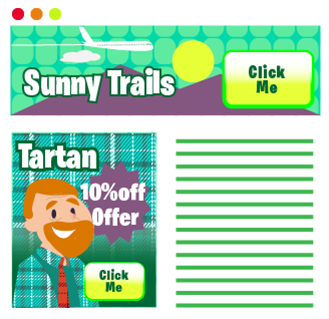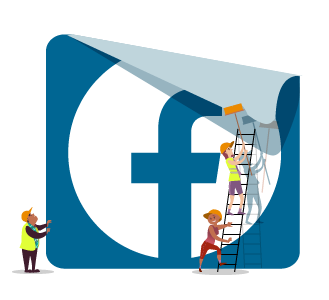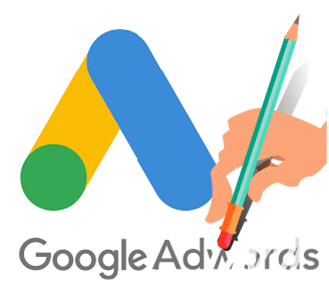Display ads, or more commonly known as banner ads, are a form of pay-per-click (PPC) advertising.
They usually come in the form of banners, and they come in all shapes and sizes.
While paid search ads appear on search engine results pages, display ads appear on the websites that are listed in those results pages—websites relevant to your product or service.
Banner ads are displayed in a network of websites. That means that your banner ad doesn’t just appear on a single website only.
For example, banner ads on Google show up on various types of websites within the Google Display Network, such as blogs, news sites, Gmail, YouTube, and more.
Why Banner Ads?
Even though banner ads use graphics, that doesn’t mean that it’s an expensive form of internet advertising.
When designed properly and run in a well-optimised campaign, banner ads can be an attractive option to use especially for small business entrepreneurs.
Banner ads can drive new traffic to your website because it can grab attention.
However, it should be noted that banner ads are not something that should be randomly chosen just for the sake of advertising the product or service intended for the target audience.
You should give careful thought towards the style and content of the banner ad as it is the first phase of the content matter the prospect is going to be exposed to, or else you’ll find yourself exceeding your advertising budget with poor results.
How do Banner Ads Work?
If you’re ready to get into advertising your banner ads, you need to know how to get your banner ads seen by internet users.
There are a few ways you can do this:
Approach Web sites yourself
Join a banner ad network
Hire an advertising agency
Start an affiliate program
Each of these options has its own advantages and disadvantages, as we will see.
Approach Web Sites Yourself
This is the simplest and most traditional method to buy banner space. It is an involved, time-consuming process, but it does offer some significant advantages.
For one, placing all your banner ads yourself gives you a lot of control over how you advertise. You can thoroughly vet candidate sites to publish on before you decide if their content matches yours.
Since this is a personal engagement, you can often work with the site to find the best location to place your ad, making it a relatively inexpensive way of advertising especially if you target small Web sites that don’t attract a lot of other advertisers.
If you choose such sites carefully, your banner ad can be reasonably effective. A small Web site that caters to a highly specific niche may not have very high traffic, but the people who do visit are more likely to engage with your ad
For example, If you sell rare 1930s pinball machines, a well-placed ad on a small antique toy collector site could bring you vast amounts of traffic.
To place advertisements this way, you have to approach each site individually, follow its particular procedures and purchase its specific advertising packages.
Start by searching the site to see if they have a page for potential advertisers. If you can’t find anything online, call the website or send them an email. Shop around for an advertising arrangement that meets your needs and fits your budget.
Larger sites will probably have a set advertising package with a relatively high price tag. You can expect to pay anywhere from $5 to $100 per thousand impressions on a reasonably popular site.
There is a wide disparity in pricing because different Web sites have different levels of popularity and various sorts of audiences.
A site with consistently high traffic will usually charge a lot more than a less popular site. If a site caters to a particular niche, it may cost more than a general interest site because its advertisers can more effectively target a specific demographic.
The amount of impressions in an advertising package varies, but 50,000 to 200,000 impressions sold at a time is typical of good-sized sites.
Smaller sites may not have even had any advertising plans, which means you might be able to work out a good deal with them.
Join a Banner Ad Network
If you want to place your banner ads on a lot of sites and don’t want to put in the time to negotiate with the sites yourself, then using a banner network is a good option.
Banner ad networks simply act as brokers between advertisers and publishers. Like banner exchange programs, they take care of placing an advertiser’s banner ads and tracking all activity related to that ad.
They also share one of the main drawbacks of banner exchange programs, however — a lack of client control. Banner networks decide where to place banner ads, and they don’t give each client the level of attention an advertising agency would.
What this means is there’s a good chance you won’t always be happy where your banner ad gets displayed.
For example, if you’re against products with animal origins, you might find your ad end up on a leather product website.
Even though you can’t control the placement of your ad, many websites readily accept this shortcoming due to the extensive reach of these networks at a relatively low cost.
You’ll definitely need to shop around to find a suitable banner network.
Most large banner networks primarily sell advertising space from high-traffic publisher sites, which may be out of your advertising budget.
There are banner ad networks that specialise in more affordable advertising space on smaller publisher sites, and a few networks offer discounted “remainder” advertising space, also called excess banner inventory, which merely includes ad space that didn’t sell at the regular price.
You should also check out networks that specialise in a particular kind of site, as they may place your ads more effectively.
Unfortunately, there are a lot of banner ad networks that promise more than they deliver and that fail to place your ads effectively, so be sure to do your homework on a network thoroughly before you join.
Hire an Agency
A full-service advertising agency will do most of the heavy lifting for you and lets you tap into their expertise too.
Agencies help you seek out suitable publisher sites, they negotiate the price of banner ad space, and they help you make the best use of your advertising budget.
Additionally, advertising agencies work with you to strategise your advertising campaigns and create professional banner ads for you.
They can often get a better price on advertising space because of their scale. These guys have a lot of clients and can buy impressions in bulk.
There are many good Internet advertising agencies, offering a wide variety of special services.
It’s clear that using an advertising agency has a lot of advantages, but it also has one significant drawback for smaller sites.
Advertising agencies usually deal only with accounts of a certain minimum size. Agencies vary considerably in reputation, services offered and size, and so also vary a great deal in price and account minimum.
That means if your business is small, they might not want to take you up as a client.
The best way to find out if an ad agency is right for you is to shop around. Find out what an agency offers, how much it charges and how much experience it has. Look at several agencies so you can make an informed decision.
And then there is also the cost. Using an agency is undoubtedly worth it for large businesses because they need the expertise and talent of professionals to make their ads competitive with rival companies’ ads.
For small businesses, it can be a significant but necessary investment, if it wants to establish itself as a significant player in their niche.
Advertising is a complicated process, and a vital ad campaign is undoubtedly best handled by experts.
If you have a limited advertising budget, however, you might do better to more of your budget towards actual banner ad placement, rather than marketing plans and top-of-the-line banner design.
Start an Affiliate Program
This is a very cost-effective way to get your banner ad on other sites.
If you set up your own affiliate program, you can arrange to pay publisher sites only when you get a specific result (such as when you make a sale or a visitor opts-in to your newsletter).
And unlike traditional banner advertising through a banner network, you don’t have to buy affiliate program clickthroughs or impressions in bulk. You only need to pay a small amount for each click, or you pay a percentage of your profit from a referred visitor.
How to Create a Winning Banner Ad
Getting Attention with a Great Punch Line
Most banner ads need a strong punch line to drive home the point of the ad and bring the overall message across.
Writing well designed and carefully thought out punch lines can entice the prospect to want to explore further.
Here are some recommendations that should be considered when designing punchlines:
Punchlines chosen should have a connective reference to the subject matter of the banner ads.
Random one-liners will not serve the purpose of the overall ad well, thus defeating the main purpose of getting the ad the recognition it deserves. If you are targeting viewers on an automobile website with a punch line about sewing, the viewers will not catch the drift.
Punchlines should not be designed to be obscure
The idea of banner ads is to reach a wide target audience and not just a small minority group. If the punch line was chosen can be understood by random people, then the correct choice was made.
Punchlines should be brief
When punchlines get too wordy, it loses focus. When the viewer is not able to instantly catch on then the punch line has not been well phrased.
Punchlines can also contain witty remarks, sound effects, facial expressions, and voice inflexions.
These can be added to create the excitement enhancing factor that will get the designed message across more effectively.
The design of the punch line should also fit the demographics of the target audience.
Think about the design aspect of the punchline, such as the font and the colour. If the design is confusing and uninteresting to the audience, it will eventually render the banner ads useless.
Writing Good Banner Copy
Having a winning banner copy can bring up the visibility and the quality of your ad. And the following are just some recommendation to consider:
Make your headline and body copy different sizes.
All copy should be four lines or less. The text size should also be visible at a glance.
Write about a value proposition
The value proposition showcases the service/product you provide and calls attention to itself with attractive offers and prices.
For example, things like: “High quality” or “50% off” or “Limited time offer” works great for a banner copy. This should take up the most space in your ad and be the first thing that viewers’ eyes see.
The size of your banner affects how much copy you can write.
Selecting the best size that would allow you to write slightly more in your banner without making it look overcrowded.
The Top 3 types of banner ads dimension are 300 x 250, 728 x 90 and 336 x 280.
Always choose static ads over flashing ads
When in doubt, you should only go with static ads over animated or flashy ads. Moving ads tend to come across as a spam-like advertisement. Unless you have specific reasons to use flashing ads (such as to enhance the design), static banners tend to work better.
Also having static ads improves the loading time thus giving the viewer a better browsing experience.
Even if your ad is static, you can still inject a subtle sense of movement to a static ad with clever use of leading lines.
Leading lines point the viewer’s eyes to a certain direction and makes sure they notice all the important parts of your ad.
Movements make your design dynamic even though it isn’t moving. And this grabs the attention of the viewers very easily.
Don’t use hard to read fonts
If viewers need a magnifying glass to read your ad copy, most likely they wouldn’t bother to click on it either.
Calls to Action that gets clicks
The call to action (or CTA) is the text or button that invites users to click.
A relevant call to action button does two important things: It reduces friction for the customers, and it increases clickthrough rate of your ad.
For banner ads, it’s better to have a clear and direct call. Familiar examples are: Sign up, Buy now, Subscribe, etc. Though the subtle or clever call to actions is often used in other forms of advertisements, it’s better to avoid those techniques here.
Placing buttons
Having buttons on your ad often increase the click-through rate (CTR).
The best position for a call to action button is in the lower right side of your ad. This position should allow the button to contrast with the rest of the ad elements visually.
Here are some more practical tips on designing call to action buttons:
Make the call to action button distinct and easily recognisable. It should be shaped like a rectangle (maybe with rounded edges).
Don’t make the call to action button too small to notice. But neither make it too big compared to the other parts of the ad.
Along with the button size, also keep an eye on the font. The call to action text should be easily readable. Otherwise, the viewers may ignore it.
It’s better if the text of the call to action can create a sense of urgency. Some of the words that you can add are – Today, Now, etc.
Using terms like “Show me,” “Sign me up” sometimes works better than “Click here” or “Sign up.” Though this is not a concrete rule, usually the pronouns You, Me, etc. grab people’s attention easily.
Using imagery well (and only when you need it)
taying out from the competition requires you to explore various ways to grab the attention of the viewer and sustain it long enough for a positive impression to be made.
Using attention-grabbing graphics is one way of doing this.
Choose relevant graphics and photos that enhance your message and are directly related to your product.
You want your message to be as clear as possible, so stay away from any abstract concepts.
If you can’t afford professional photography or supermodels, why not buy an affordable license for a stock photo. There are millions of high-quality ones out there. Better still, opt for original illustrations or graphics created by a designer.
Remember, it’s not always necessary to use images in your banner ads. Killer copy and nice typography can create equally effective results.
Playing smart with colours
The choice of colour is a crucial point for designing banner ads.
Each colour represents a specific type of emotion. It can be difficult to select the perfect colour combination because it depends on your brand, target audience and advertisement type.
Still, it’s possible to figure out some general rules regarding colour choice in online ads. In general, lighter colours represent youth and energy, while dark colours represent reliability and experience.
More often than not, the colour used in your ads should be related to your products.
For example, green is a great choice for natural or organic products. Purple is good for high-end items. The background colour of the ad significantly influences how the text and buttons appear to the viewers.
Banner Ad Landing Pages
When a user clicks on your display ad for a discount coupon, sending them to your business’s blog is unlikely to result in them taking the action you want them to take.
Instead, you’ll want to give the offer that the user is looking for, that subsequently helps you to convert the user into a customer.
For a banner ad to be effective, make sure to follow landing page best practices.
Keep a consistent design and message between your ad and landing page. This provides a seamless experience for the user.
It’s also important to have the same values and deals mentioned in the ad appear again on your landing page, so the user doesn’t feel disjointed (or worst, short-changed).
Real-Time Bidding
Demand-side platforms (DSP) and real-time bidding are systems that provide advertisers features for buying where they want their ads to be placed online, in real time.
With real-time bidding, you can help increase the effectiveness of your display ads.
Demand-side platforms obtain data about users from across the web, to reveal which age, gender, and demographic groups are interested in which topics.
All these demographic information is used in real-time bidding, which is the process by which a display ad gets selected for a page in the time that it takes the page to load.
Demand-side platforms and real-time bidding help advertisers to target online users most likely to purchase their product or service, giving them the most bang for their advertising buck.
Measuring the success of your Display Marketing Banner Ads
After your business invests in display advertising, it is important to understand some key metrics that you will encounter throughout your engagement.
This would allow you to have a clearer picture of the performance of your banner ad campaign and understand the direction you are heading.
For example, you can tell which ads are doing better than the rest, which ones you should get rid of or tweak
Impressions
Impressions refer to the number of people who can potentially view your advertisement online. Typically, this will be represented by the number of visitors that visit the advertisement network you are planning to use.
Clickthrough Rate (CTR)
The clickthrough rate is used to measure how many clicks your ad is receiving from users. This is generally used as a benchmark by advertising agencies to gauge how well an advertisement or a campaign is received by the audience.
Bounce Rate (BCR)
Bounce rate is the percentage of visits that go only to one page before exiting the site.
When a user bounces on a page that was advertised by a display advertisement, it indicates that the user was intrigued enough to click on the advertisement, but when they visited your site, they found that what they saw on the advertised page is not relevant to them.
This usually happens when there is a mismatch between your ad and your landing page, as mentioned earlier.
Some factors contribute to your bounce rate. For example, visitors might leave your site from the entrance page if there are site design or usability issues. Alternatively, visitors might also leave the site after viewing a single page if they were not able to find what they were expecting.
Conversion Rate (CVR)
The conversion rate basically tells you what percentage of the people clicking through the ad, and ended up completing an action or a goal that you desire. This could be anything from a purchase made online, a registration for a newsletter or even a request for more information.
Return on Investment (ROI)
When brands embark on display marketing, there is always a cost involved together with a goal to be achieved.
Return on investment in layman’s tries to quantify how much value is obtained for every pound you spent.
For example, imagine an advertisement that will run for a month before Valentine’s Day that you are using to drive traffic from search engines to market flowers across the UK.
If the cost of the campaign was £10,000 and the sales generated by the campaign was £50,000, this means that for every £1 spent, the brand earned £5 back.
In closing
Display advertising is a great way to familiarise more people with your business and build your online presence.
As advertising needs become more sophisticated, banner ads can also be personalised to provide a unique advertising experience for your potential clients.
This opens doors to a mind-boggling array of advertising opportunities to drive traffic and buyers to your business, making it a formidable marketing tool for any business.







